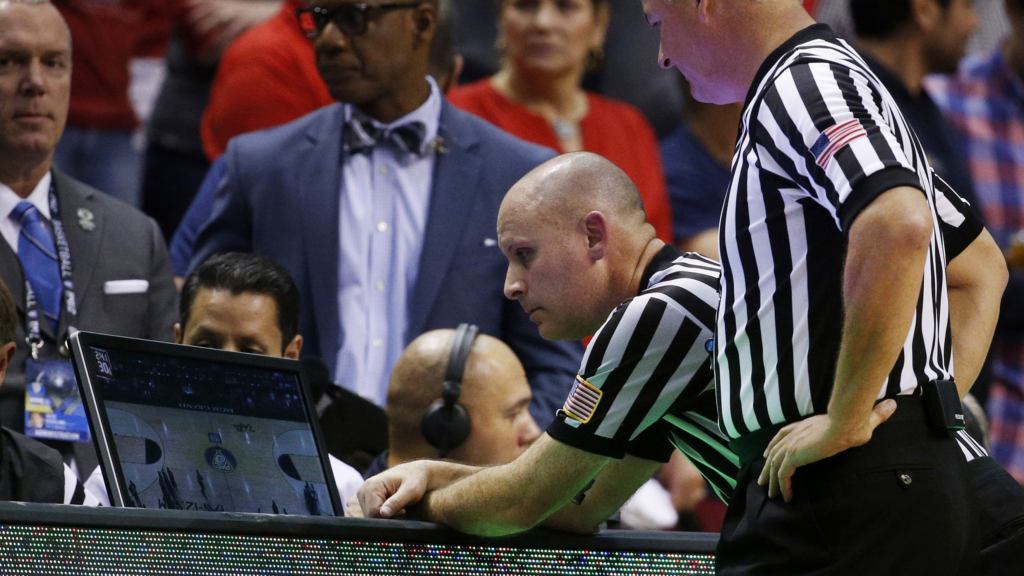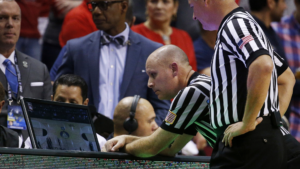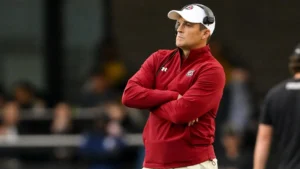
Implementing a Coach’s Challenge and Transitioning from Halves to Quarters in NCAA Basketball: An Analysis
The landscape of collegiate basketball has evolved significantly over the years, with the game itself undergoing continuous modifications to enhance its competitiveness, maintain viewer engagement, and improve the overall experience for players and coaches alike. One of the more recent discussions within the NCAA is the potential shift from the current system of two halves per game to a format consisting of four quarters, similar to the professional game (NBA) and international basketball (FIBA). Alongside this potential change, there has been conversation surrounding the introduction of a coach’s challenge system, which would give head coaches the ability to contest certain calls made by referees during a game.
This essay explores the potential impact of transitioning NCAA basketball to a quarters system, coupled with the implementation of a coach’s challenge, by analyzing the reasons behind these changes, the benefits, and challenges, as well as the implications on the game’s pace, fairness, and overall structure. It will also examine how the coach’s challenge might influence decision-making, the game’s flow, and its competitiveness, while taking into account the broader context of basketball as a sport, its history, and its future development.
Historically, NCAA men’s basketball has been played in two 20-minute halves, a structure that has its roots in the game’s earlier history, including high school basketball, which still typically employs the two-halves system. However, many basketball leagues, including the NBA and FIBA, have transitioned to four 12-minute quarters. This format has been widely adopted in an effort to better manage game flow, promote player rest, and maintain a consistent rhythm of play. As the NCAA seeks to modernize its product and align with the evolving landscape of basketball, there are several compelling reasons why a shift to quarters could make sense.
One of the most prominent advantages of shifting to quarters is the way it can impact game flow. In the current format of two halves, players often experience extended periods of play with fewer natural breaks. This can lead to fatigue, which can compromise performance, particularly in high-intensity games. Under the quarters system, teams would have regular breaks between each period, providing more opportunities for players to rest, refocus, and receive strategic adjustments from their coaches. These breaks can also contribute to reducing the risk of injuries, as players would not be expected to play such long, uninterrupted stretches of time.
Moreover, the increased stoppages with quarters would lead to more consistent pacing throughout the game. Under the current halves system, teams can experience drastic shifts in momentum, especially as halftime provides a lengthy interlude that can alter the energy and flow of the game. The quarter system creates smaller, more manageable segments, making it easier for teams to make tactical adjustments and keep up with the tempo of the game. The shorter breaks between quarters help maintain an intense level of play without excessive pauses.
Another reason for moving to quarters is the alignment with international and professional basketball. The NBA, FIBA, and the NCAA’s Division I Women’s Basketball all use a four-quarter system, and this familiarity between different levels of the game can help players transition more easily when they move from one stage of competition to another. By standardizing the format, the NCAA would be providing a more seamless experience for players transitioning from high school to college basketball, or from college to professional leagues like the NBA.
For coaches, this transition would also simplify strategy. They are already familiar with managing player rotations, fouls, and substitutions under the quarter system. Having these commonalities across different levels of play can reduce confusion and make for a smoother, more consistent experience for both coaches and players.
One significant advantage of moving to quarters is the impact on foul management. In the current system, players accumulate fouls over the course of two halves, with the team’s bonus situation only coming into effect after a certain number of fouls are committed. Under a four-quarter system, teams would have a reset after each quarter, which helps in managing the fouling situation. This ensures that teams are not penalized with bonus free throws for excessive fouls early in the game, allowing coaches to better strategize around player fouls and avoid situations where a team’s aggressive defense could result in unnecessary foul trouble late in the game.
For example, in the current system, a team could accumulate a high number of fouls in the first half, which could lead to an unfair advantage for the opposing team in the second half. With the quarters system, teams would start fresh after each period, preventing fouls from carrying over in a detrimental way.
Alongside the potential shift to quarters, another significant development being considered by the NCAA is the introduction of a coach’s challenge. This would allow head coaches to contest specific calls made by referees during the game, providing an additional layer of accountability and transparency to the officiating process.
The concept of a coach’s challenge has gained traction in several professional sports, including the NBA and NFL, where it is seen as a way to ensure that important calls are reviewed, especially in high-stakes moments. While college basketball has traditionally relied heavily on referees’ judgment, the increasing pace of the game, the complexity of the rules, and the scrutiny from fans and players have all contributed to calls for greater accuracy in officiating. The introduction of a coach’s challenge could help address these concerns by providing coaches with an avenue to contest calls they believe are incorrect.
The primary benefit of a coach’s challenge is that it provides coaches with an opportunity to challenge calls they believe to be egregious or incorrect. In a sport like basketball, where decisions around fouls, travels, and out-of-bounds plays can significantly influence the game, the ability to review a call can help ensure that the right decision is made. This can promote a greater sense of fairness for both teams, knowing that there is an avenue for accountability when important calls are made.
The NCAA has been criticized in the past for instances where controversial calls were made in crucial moments of games, potentially influencing the outcome. While human error is inevitable, the use of technology and replay systems can mitigate these errors, helping to ensure that the game’s integrity is preserved.
A coach’s challenge would provide a more transparent system for reviewing calls and allow for better accountability in officiating. Fans, players, and coaches often question the integrity of certain calls, and the introduction of technology could help mitigate any skepticism surrounding officiating. Review systems like those already in place in the NBA, where referees can examine replays of pivotal moments during games, can be used to evaluate and adjust calls based on visual evidence, ensuring that the fairest possible decision is made.
Moreover, giving coaches the ability to challenge certain calls would likely improve the overall quality of the officiating process. Knowing that their decisions may be reviewed and potentially overturned could encourage referees to be more cautious and conscientious in their decision-making.
One concern about the coach’s challenge is the potential for misuse or overuse, particularly in the form of coaches challenging every close call in an effort to gain an advantage. To avoid this, the NCAA could implement certain restrictions, such as limiting the number of challenges a coach can use per game, or only allowing challenges during certain types of plays, like controversial fouls or out-of-bounds situations. For instance, a coach might only be allowed one challenge per half, or if their challenge is successful, they might be granted an additional opportunity. This ensures that the challenge remains a tool for fairness rather than a tactical gimmick.
While the potential benefits of both transitioning to quarters and introducing a coach’s challenge are clear, there are several challenges and considerations that need to be addressed before such changes are implemented in the NCAA.
One of the primary concerns with transitioning to quarters is the potential increase in overall game length. While each quarter would be shorter than the current 20-minute halves, the additional stoppages for breaks and timeouts could lead to longer overall game times. This could be especially true if the coach’s challenge is frequently used or if games involve extended review periods. Game time would need to be carefully monitored to ensure that it remains manageable for both players and fans, as excessively long games could become tiresome and detract from the excitement of the competition.
Implementing a coach’s challenge would require significant upgrades to the NCAA’s existing infrastructure for officiating, including access to video review systems and technology that can handle replay requests efficiently. Additionally, there would need to be clear guidelines and protocols in place to ensure consistency in the way challenges are used across different games and tournaments. This could require training for both officials and coaches to ensure that the system is used effectively and fairly.
As with any major change, there will likely be some resistance from traditionalists within the NCAA basketball community who may view the shift to quarters and the introduction of a coach’s challenge as unnecessary changes to the game’s tradition. Many college basketball fans and coaches may argue that the current system has served the game well for many years, and that new changes may disrupt the rhythm of the game. Balancing the desire for innovation with respect for the sport’s history will be a critical part of the conversation surrounding these potential changes.
In conclusion, the proposal to shift from halves to quarters and introduce a coach’s challenge in NCAA basketball represents a significant step toward modernizing the game. The move to quarters promises to improve game flow, offer better management of team fouls, and align college basketball with international and professional standards. Meanwhile, the coach’s challenge has the potential to promote fairness and transparency, ensuring that critical calls are reviewed and corrected when necessary.
While these changes present challenges in terms of implementation and potential resistance from traditionalists, the long-term benefits for the sport could be substantial. With careful planning and execution, the NCAA could usher in a new era of basketball that combines innovation with the rich tradition of college basketball, enhancing the experience for players, coaches, and fans alike.





